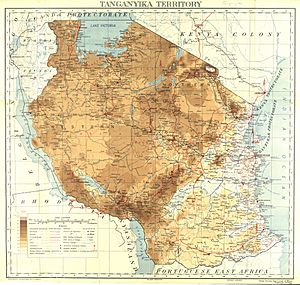Tanganyika groundnut scheme facts for kids

The Tanganyika groundnut scheme was a big plan by the British government. It aimed to grow lots of peanuts (also called groundnuts) in Tanganyika. This area is now part of Tanzania.
The project started after World War II. Britain needed more cooking oils and fats, especially for margarine. The goal was to grow peanuts on a huge area of land. This would help Britain and develop Tanganyika.
But the plan was a disaster. It cost a lot of money, about £36 million (over £1 billion today). It failed because the land and weather were not right. Also, the project was rushed and poorly managed. It was finally stopped in 1951. Many people saw it as a symbol of government mistakes.
Contents
Why the Groundnut Scheme Started
After World War II, Britain owed a lot of money. The government wanted to grow more food in its colonies. This would help Britain rely less on other countries. It was also a way to develop these areas.
In 1946, a man named Frank Samuel had an idea. He led a company called the United Africa Company. He suggested growing peanuts in Tanganyika. Britain still had food rationing. They really needed cooking oils and fats.
He told John Strachey, who was the Minister of Food. Strachey liked the idea. In April 1946, a team visited Tanganyika. They checked the land to see if it was suitable.
Planning the Peanut Farms
The team's report in September 1946 was very positive. They said the plan could work. They suggested growing peanuts on over 3 million acres by 1952. The government agreed in January 1947.
They started sending people and machines to Tanganyika. They even recruited former soldiers for the "Groundnut Army." About 100,000 soldiers volunteered for just 1,200 jobs.
Challenges of Growing Peanuts
The first group of workers set up camp at Kongwa. This was near Dodoma, which is now Tanzania's capital. They thought the area was good for peanuts. But it had a lot of clay soil and not much water. Kongwa became the scheme's main base. A whole town grew there, called 'Half London' by locals.
Getting Equipment to the Farms
It was hard to get the right heavy machines. These were needed to clear the land. They found some tractors and bulldozers from Canada. They also bought old U.S. Army surplus tractors. Many of these were too rusty to use.
Then, the machines had to travel through the Port of Dar es Salaam. The port became very crowded. The only way to get inland was a single-track railway. It used old steam trains. A sudden flood then washed away part of the railway. This left only a dirt road. So, the bulldozers were delayed until April 1947.
Fighting the African Bush
Clearing the land was much harder than expected. Workers faced angry elephants and rhinoceros. Also, the huge local baobab trees were very tough to remove. Some trees were special to local tribes. Many had bees' nests in their hollow trunks. Several workers ended up in the hospital from bad bee stings.
The heavy machines broke down quickly. By late 1947, two-thirds of the imported tractors were unusable. Bulldozer blades used to pull out roots were ruined in days. The scheme even used old Sherman tanks. They removed the armor and added bulldozer blades. These were called "shervicks." But even these could not handle the tough African bush.
Later, in a wooded area, they found a better way. They linked a long chain between two bulldozers. This would flatten all the trees in between. A third bulldozer would then flip over any trees that resisted.
Workers and Weather Problems
In September 1947, African workers went on strike for three days. The foreign staff had to do their own cooking. More Africans were hired as tractor drivers. After some early mistakes, they became very skilled.
Finally, the "Groundnut Army" planted the first peanuts. But when the rainy season came, floods washed away some workshops. After that, the hot season baked the clay soil. It became so hard that harvesting the nuts was very difficult.
Changes and the End of the Scheme
In February 1948, a new group took over the project. It was called the Overseas Food Corporation (OFC). They sent a new manager, Major-General Desmond Harrison. He found the project in chaos. He tried to bring in military order. But he soon focused on paperwork instead.
In 1949, the Kongwa area had a terrible drought. This ruined most of the peanut crop. After two years, they harvested only 2,000 tons of peanuts. This was less than the amount they had imported as seeds. They tried growing sunflowers instead, but they also failed due to the drought.
New Plans and Railway Building
The managers then looked at more fertile areas. These were in the west and south of Tanganyika. But developing these areas was very slow. In the south, they needed a whole new railway line. They also had to build a deep-water port from scratch at Mtwara.
The Southern Province Railway was built first. It was meant to carry the crops. But it never had any crops to transport. It was later taken apart.
The original goal was to clear 3 million acres. This was first cut to 150,000 acres. Then it was cut again to 50,000 acres. In the end, only 47,000 acres were ever cleared.
The Scheme is Cancelled
By late 1949, the project faced strong criticism. People in Parliament and the news were unhappy. The government kept trying, but it hurt them in elections.
Finally, in January 1951, the project was cancelled. The government lost £36.5 million. This is over £1 billion in today's money. The machine-based farming stopped. The cleared land was given to African farmers. They did a much better job growing tobacco, cashew nuts, and raising cattle.
Further readings
- Nicholas Westcott (2020), Imperialism and Development: the East African Groundnut Scheme and its legacy, Woodford, Sussex: James Currey, ISBN: 978-1-84701-259-3

